Rebreathers, particularly Closed Circuit Rebreathers (CCR) take a lot of concentration and unprecedented amounts of attention to detail compared with traditional scuba. Watching CCR divers underwater it’s a wonder what they actually get to see considering that 50% of the dive is spent staring at up to three LCD displays waiting for them to potentially read you your last rites. Similar to frying bacon with your shirt off – CCR’s can have some disastrous consequences if you don’t keep on top of things and/or if taken to extremes. I’ve taught different types of rebreathers since 1996 and while I appreciate that customers might want the choice between regular scuba and CCR in a vain attempt to emulate an Action Man or simply look ‘cooler’ there should be at least some kind of ‘Stewards Enquiry’ started to try and stem the needless loss of life that complacency or ineptitude with a rebreather tends to reward, lets not even start with ‘ready meal’ all-in-a-weekend training courses and 1 hour crossover instructor specials that plague the scuba business. Some of these units have been implicated in almost 40 deaths but the waiting list in months for buying them keeps growing. The average wait in months for a popular unit is almost the square root of the number of people killed while wearing one (6!). It’s not all doom and gloom though, CCR’s used sensibly and within manufacturer and training guidelines can be both a fun and also eerily silent way to explore the deep.
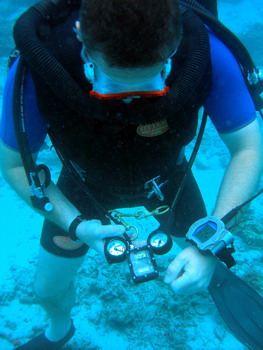
Now that the CE marking system on products means little more than Chinese Export – where better to buy a closed circuit rebreather unit than one designed and manufactured on Koh Samui in Thailand? Home to thousands of Lady Boy conversion/snipping clinics and the virtual Cambridge University for macaque monkeys entering coconut picking careers the world over, Samui sits in the Gulf of Thailand, an hours flight south of Bangkok, the Nations capital. Thailand may seem a surprising birthplace for advanced, life supporting, underwater apparatus and maybe rightly so – considering its a country that builds new roads around telephone poles, but such things as Laptops and cameras, plus all manner of other high end electrical equipment are produced by pre-pubescent hands in the Land of Smiles, so why not Boxes of Death as rebreathers units are affectionately / ironically known?
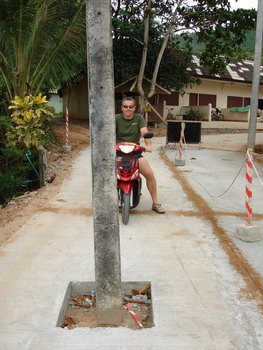
While not a huge fan of Closed Circuit Rebreather equipment in the hands of amateurs with just a couple of weekends training, I’m none the less open minded when it comes to companies trying to improve safety and build-quality in these potentially very dangerous forms of scuba. Electronics and water don’t mix too well, a bit like Baileys liqueur and Coca-cola, but of course mixed slowly a modicum of success is achievable, especially if a level of intoxication is already in place. Rebreather units that rely heavily on electronics, sensor regulation, and a heavy sprinkling of marketing hype and user complacency usually mean tragic newspaper headlines – However, CCR units relying on constant user input and manual/semi constant oxygen addition have a seemingly attractive in-built level of user longevity.
Some would say that rebreathers are as predictable as having a monkey on your back. While that may be true with many units/monkeys, some have more refined habits and table manners!
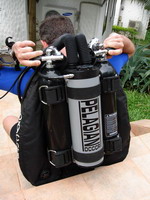

Rebreather Lab, a company managed by Engineer and Dive Instructor Andreas Fritz who has been based in Koh Samui for the last 8 years. Andy contacted me some months back with a view to show-casing his new Pelagian Diver Controlled CCR and try to change my views on rebreather technology.
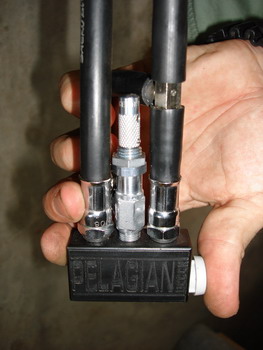
The Pelagian rebreather works similarly to the manual addition and constantly-flowing gas supply principles employed in the KISS rebreather unit already used extensively worldwide with a surprisingly low rate of users throwing sevens compared to the largely fully-electronic and therefore problematic competition. Diver controlled rebreather units employ a regulated and diver controlled metered valve system to introduce oxygen to the diver at a rate usually just below a divers’ metabolic need. The constant but low flow rate helps users avoid the life threatening Hyperoxic tendencies associated with electronic CCR units while giving some minutes reparation time (depending on depth) before Hypoxia becomes a full blown swan-dive from the top of Nelsons Column. These so-called Diver-controlled CCR users are drilled/trained to maintain Po2 values constantly throughout their tuition courses as no automated addition systems are in place to ‘protect’ the complacent. In principle the need to add/maintain oxygen levels yourself seems very much more reliable in use than the plethora of electronic controls used in more complex but statistically more deadly fully electronic versions.
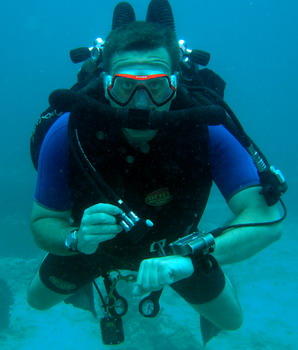
While the KISS units are designed to max out in the 110metre depth range by function of their gas supply regulators, the Pelagian differs in that no on-board component has been designed to limit achievable depth. In fact, the Pelagian’s electronics are designed to work flooded and even without their protective cases so any depth related implosions won’t be an immediate train crash. Apparently, Rebreather Lab has sold its metered valve system to many existing KISS users who desire to know what 150 metres depth feels like with only a half filled 3litre pony bottle for company…let me tell them – a 3 litre bottle used below 40metres is as safe as a crisp-packet parachute!
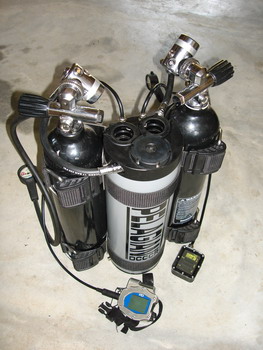
I have used many different types of rebreathers over the years and what I immediately noticed about the Pelagian is its obvious build quality and size. Andy and his team at Rebreather Lab have exhaustedly tried different materials during prototype evolutions finally using the veritable ‘alien-spacecraft-hull’ Acetal-co-polymer for the units core parts. Most divers would be aware of Delrin as a material of quality for such uses but Acetal-co-polymer is immeasurably superior and makes Delrin look like sugar glass in comparison. Delrin is an okay material, it is much cheaper to buy and easy to produce items from – this combined with its free-availability, makes it the ideal material of choice for the more ‘mainstream’ dive equipment manufacturers but it suffers from stress-cracking and as such was dropped from the material choice list for the Pelagian . The use of Acetal-co-polymer in the Pelagian’s construction wouldn’t impress company accountants but will please the end user both now and likely far into the future.
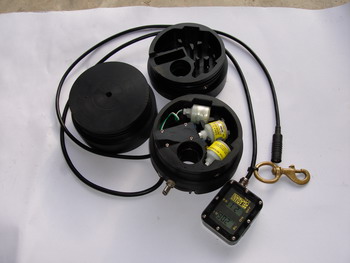
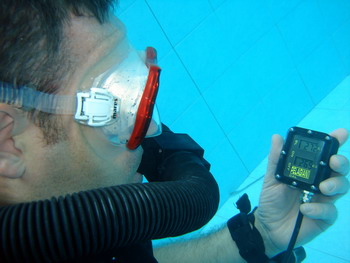
Andy gave me a brief tour of the factory and explained the how’s and whys behind the unit’s design then set about building up a rebreather completely from the parts bin to fit me. Virtually all the components are built from scratch in-house, only the rebreather hoses are outsourced from a company in the United States. The Pelagian is supplied in kit form, the user expected to add things like pressure gauges, a couple of oxygen analyser cells plus a buoyancy wing and back-plate plus a few other odds and sods. Completely assembled with the twin 2.6 litre dive tanks and 2.85kg’s of Carbon Dioxide absorbent the unit weighs about the same as 10litre twin-set. The company states a maximum in-water time of 4 hours in cold water and 6 hours in warm – somewhat longer than twin 10’s. Unit assembled I jumped into the pool that adjoins the workshop and classroom facilities at Rebreather Lab HQ, very Tracey Island ‘esque’ really. I’m aware of the number of fatalities of CCR users in a shallow swimming pool and to make sure I didn’t swell those numbers stared at the po2 displays like they were showing my winning lottery numbers! As luck would have it the pool session was drama free and I was impressed with the work of breathing as I changed body position from face down swimming to surface gazing. I thought maintaining a constant partial pressure of oxygen (set point) would mean constant fiddling on such a unit in the shallows but the effort of adjusting flow-rates became minimal with just tiny changes to the metered valve necessary after only 30 minutes of practice drills. After just an hour in the pool I felt confident enough to take the unit into the proper sea to stretch both its and my legs A scheduled day trip to the nearby island of Koh Tao was booked with the normal 1 hour speedboat trip looking ominous and likely to double with the storm sized winds that were buffeting the area. Getting up at 6.30am was bad enough but within an hour we were all bouncing up and down like Tourettes sufferers on pogo sticks wedged into the triple-engined speedboat driven without let-up through the walls of green water gut wrenchingly.
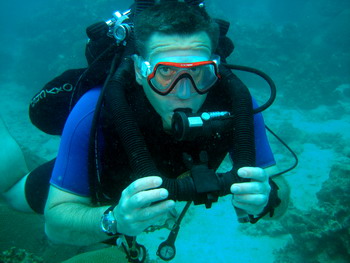
The Pelagian has an inbuilt auto-diluent-valve (ADV) which the unit designers have tailored to fit neatly into the scrubber lid itself. The ADV’s position in the lid means any fresh gas added is blown across the oxygen sensors in an attempt to rid them of oxygen-value-altering water droplets – a problem with some units but not this one. Dropping over the side into angry seas was a bit of a chore and we aimed to head down as quick as possible. Descending so fast normally would collapse a rebreather’s breathing bags unless it has an ADV fitted – as it did, no problem. I was pleased to be able to breathe comfortably during the frantic descent. Hitting 20 metres at the Chumphon Pinnacle dive site meant instant tranquillity and gave time to tinker with the oxygen addition valve to get the set point up to 1 bar. This done I started going through practise drills while Iona the photographer snapped away like a manic Japanese tourist. Closing the mouthpiece was easy enough and switching to a functioning bail-out regulator is always reassuring. Andy from Rebreather Lab was swimming close by wearing his newly acquired and almost vintage looking Cis Lunar unit occasionally prompting me to respond to a pretend problem. Back in the day the CIS was the Lamborghini Gallardo of rebreathers, though a decade on it now resembled a MK 2 Ford Escort. Having dived both units, the young upstart Pelagian was clearly my favourite – much lighter to wear and far easier to breathe from. Funnily enough the Pelagian fitted into my travelling backpack so would be ideally suited for holidaying with – the Cis Lunar would struggle to fit into a 40 foot container!
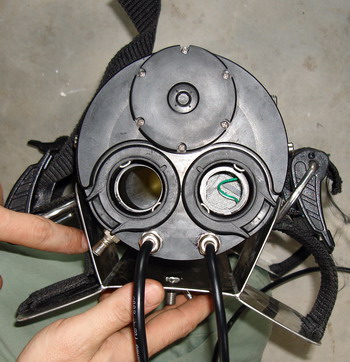

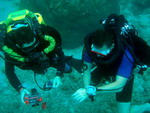
To the left an idyllic beach scene on Koh Tao. To the right, Andy and I botch a camera pose while looking at something possibly interesting!
The Pelagian has an unusual breathing bag configuration in that they curve around you starting from shoulder blades and ending near the hip. More interesting is that they are constructed of motor cycle inner tube! Rebreather Lab wouldn’t be the first technical equipment manufacturer to use inner tubes but at least they use brand new ones. Obvious advantages of using inner tube is that punctures are easily fixed and that as shown on mopeds worldwide they will likely last many years. I didn’t notice any perceptible rubber smell, only the clinical smell of the sterilising fluid used to clean them. The slim line breathing bags are completely out of the way and don’t seem to be affected at all by hydrostatic loadings (if we are being posh), or body position if we isn’t. An overpressure valve is placed on the breathing bags of course but as it would only trigger just before the bags burst it makes more sense to exhale through the nose when necessary to lose loop volume. I spent two days learning the unit in the sea, the diving conditions were typically low season and the green hue in the water didn’t make for brilliant underwater photos or enhance the chances of seeing anything other than the usual macro-fodder.

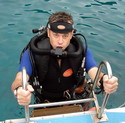
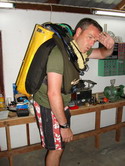
I suppose if I wanted a rebreather for personal use the Pelagian would be a good choice. I’ve certainly seen enough rebreathers over the years I didn’t like – some sporting CE marking, but all looking like they were blown together with parts from B&Q, Tandy’s and Osma . I did like the size and transportability of the unit. The predictability of its gas supply method is another plus point and of course the impressive build quality. My only concern was the lack of audible or tactile alarm in the event of high or low inspired oxygen. You decide. Contact Andy at www.Rebreatherlab.com for more details and training options.
